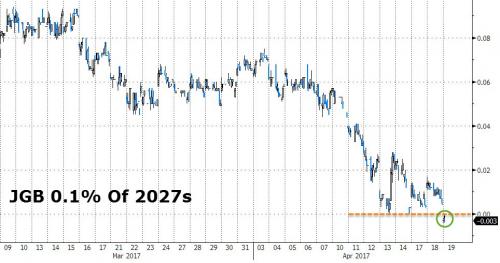With every other asset class round tripping the November election outcome, it was only a matter of time before Japan’s 10Y JGB – which on February 2 briefly peaked above the BOJ’s “yield curve controlling” 0.10% yield ceiling, rising as high as 0.15% to the shock of a market ready to declare that Japan had finally lost control of its bond market – retraced the entire “reflationary” move from 0.0% to 0.1%. And, sure enough, following today’s violent deflationary capitulation moments ago Japan’s JGB 0.1% of 2027 once again dipped back under 0%, sliding as low as -0.003% on Wednesday morning in Japan.

What happens next?
According to traders, focus will turn to whether the BOJ, in pursuing “yield curve control”, will reduce the amount of JGBs it monetizes.”Amid favorable environment for bonds, focus is on BOJ as whether there will be a reduction in purchase amounts will test the bank’s tolerance for 10-year yield falling into negative,” Katsutoshi Inadome, senior bond strategist at Mitsubishi UFJ Morgan Stanley Securities, wrote in note according to Bloomberg.
As a reminder, in the BOJ’s latest “rinban” or open market operation, it bought around 280bn yen of 1-to-3, 350bn yen of 3-to-5 and 450bn yen of 5- to-10-year maturities at previous operation. And material declines from these amounts may lead result in the market roiling again, on fears the BOJ is being forced into an involuntary taper by external deflationary forces.
Meanwhile, the USDJPY continues to track treasury yields tick for tick, and as Yujiro Goto, senior FX strategist at Nomura in London said, the “dollar/yen remains top-heavy with yields falling and weak U.S. economic data. It’s hard to take risk aggressively ahead of the French election, keeping it in 108-109 range.”
Which means that while continued declines in Japanese yields are virtually assured all else equal, it will be up to the BOJ to telegraph to the market just how low it will let the 10Y drop. Should Kuroda unveil another “taper”, the result may be the uncoordinated move in global bond markets, leading to a negative feedback loop of JGB selling and TSY bond buying, which incidentally is the worst case scenario for global central bankers whose primary intention over the past year has been to achieve as much rate coordination as possible.









Leave A Comment